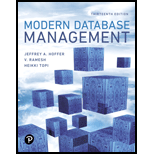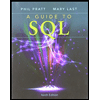
Modern Database Management
13th Edition
ISBN: 9780134773650
Author: Hoffer
Publisher: PEARSON
expand_more
expand_more
format_list_bulleted
Question
Chapter 5, Problem 5.3RQ
(a)
Program Plan Intro
Differentiate between Scalar Aggregate and
(b)
Program Plan Intro
Differentiate between DDL and DML.
(c)
Program Plan Intro
Differentiate between catalog and Schema.
Expert Solution & Answer
Want to see the full answer?
Check out a sample textbook solution
Students have asked these similar questions
A. What will be printed executing the code above?B. What is the simplest way to set a variable of the class Full_Date to January 26 2020?C. Are there any empty constructors in this class Full_Date?a. If there is(are) in which code line(s)?b. If there is not, how would an empty constructor be? (create the code lines for it)D. Can the command std::cout << d1.m << std::endl; be included after line 28 withoutcausing an error?a. If it can, what will be printed?b. If it cannot, how could this command be fixed?
Cisco Packet Tracer
Smart Home Automation:o Connect a temperature sensor and a fan to a home gateway.o Configure the home gateway so that the fan is activated when the temperature exceedsa set threshold (e.g., 30°C).2. WiFi Network Configuration:o Set up a wireless LAN with a unique SSID.o Enable WPA2 encryption to secure the WiFi network.o Implement MAC address filtering to allow only specific clients to connect.3. WLC Configuration:o Deploy at least two wireless access points connected to a Wireless LAN Controller(WLC).o Configure the WLC to manage the APs, broadcast the configured SSID, and applyconsistent security settings across all APs.
Transform the TM below that accepts words over the alphabet Σ= {a, b} with an even number of
a's and b's in order that the output tape head is positioned over the first letter of the input, if the
word is accepted, and all letters a should be replaced by the letter x.
For example, for the input aabbaa the tape and head at the end should be:
[x]xbbxx
z/z,R
b/b,R
F
①
a/a,R
b/b,R
a/a, R
a/a,R
b/b.R
K
a/a,R
L
b/b,R
Chapter 5 Solutions
Modern Database Management
Ch. 5 - Define each of the following terms: data...Ch. 5 - Match the following terms to the appropriate...Ch. 5 - Prob. 5.3RQCh. 5 - Prob. 5.4RQCh. 5 - Prob. 5.5RQCh. 5 - Prob. 5.6RQCh. 5 - List six potential benefits of achieving an SQL...Ch. 5 - Prob. 5.8RQCh. 5 - Distinguish among data definition commands, data...Ch. 5 - Prob. 5.10RQ
Ch. 5 - Prob. 5.11RQCh. 5 - Explain the purpose of indexing in database...Ch. 5 - What are the potential consequence of...Ch. 5 - Prob. 5.14RQCh. 5 - Explain and provide at least one example Of how to...Ch. 5 - Prob. 5.16RQCh. 5 - What is the difference between COUNT, COUNT...Ch. 5 - What is the evaluation order for the Boolean...Ch. 5 - If an SQL statement includes a GROUP BY clause,...Ch. 5 - Prob. 5.20RQCh. 5 - Prob. 5.21RQCh. 5 - Prob. 5.22RQCh. 5 - Explain why SQL is called a set-oriented language.Ch. 5 - When would the use of the LIKE key word with the...Ch. 5 - Prob. 5.25RQCh. 5 - Prob. 5.26RQCh. 5 - In what order are the clauses of an SQL statement...Ch. 5 - Within which clauses of an SQL statement can a...Ch. 5 - Prob. 5.29RQCh. 5 - Prob. 5.30RQCh. 5 - Prob. 5.31RQCh. 5 - Explain the difference between the WHERE and...Ch. 5 - Prob. 5.33RQCh. 5 - Write a database description for each of the...Ch. 5 - Analyze the database to determine whether or not...Ch. 5 - Prob. 5.36PAECh. 5 - To enforce referential integrity, before any row...Ch. 5 - Write SQL data definition commands for each of the...Ch. 5 - Write SQL commands for the following: Create two...Ch. 5 - Write SQL queries to answer the following...Ch. 5 - Write SQL queries to answer the following...Ch. 5 - Write SQL queries to answer the following...Ch. 5 - Write SQL queries to answer the following...Ch. 5 - Prob. 5.44PAECh. 5 - Prob. 5.45PAECh. 5 - Prob. 5.46PAECh. 5 - What is the average Read score for all students?...Ch. 5 - Prob. 5.48PAECh. 5 - What are the TutorIDs for tutors who have not yet...Ch. 5 - Prob. 5.50PAECh. 5 - Prob. 5.51PAECh. 5 - Prob. 5.52PAECh. 5 - Prob. 5.53PAECh. 5 - Prob. 5.54PAECh. 5 - How many tutors have an Active status in the...Ch. 5 - Prob. 5.56PAECh. 5 - Modify the Product_T table by adding an attribute...Ch. 5 - Enter sample data of your own choosing into...Ch. 5 - Add an order to the Order_T table and include a...Ch. 5 - Use the Pine Valley database to answer the...Ch. 5 - Prob. 5.61PAECh. 5 - Prob. 5.62PAECh. 5 - Prob. 5.63PAECh. 5 - Prob. 5.64PAECh. 5 - Prob. 5.65PAECh. 5 - Prob. 5.66PAECh. 5 - Prob. 5.67PAECh. 5 - Modify query in P&E 5-67 by considering only those...Ch. 5 - Prob. 5.69PAECh. 5 - Prob. 5.70PAECh. 5 - Prob. 5.71PAECh. 5 - Prob. 5.72PAECh. 5 - Prob. 5.73PAECh. 5 - Prob. 5.74PAECh. 5 - Prob. 5.75PAECh. 5 - Prob. 5.76PAECh. 5 - Prob. 5.77PAECh. 5 - Assume that for those materials the ID of which...Ch. 5 - Prob. 5.79PAECh. 5 - Prob. 5.80PAECh. 5 - Prob. 5.81PAECh. 5 - Prob. 5.82PAECh. 5 - Prob. 5.83PAECh. 5 - Prob. 5.84PAECh. 5 - Prob. 5.85PAECh. 5 - Prob. 5.86PAECh. 5 - Prob. 5.87PAECh. 5 - Prob. 5.88PAECh. 5 - Prob. 5.89PAECh. 5 - Prob. 5.90PAECh. 5 - Prob. 5.91PAECh. 5 - Prob. 5.92PAECh. 5 - Prob. 5.93PAE
Knowledge Booster
Similar questions
- Given the C++ code below, create a TM that performs the same operation, i.e., given an input over the alphabet Σ= {a, b} it prints the number of letters b in binary. 1 #include 2 #include 3 4- int main() { std::cout > str; for (char c : str) { if (c == 'b') count++; 5 std::string str; 6 int count = 0; 7 char buffer [1000]; 8 9 10 11- 12 13 14 } 15 16- 17 18 19 } 20 21 22} std::string binary while (count > 0) { binary = std::to_string(count % 2) + binary; count /= 2; std::cout << binary << std::endl; return 0;arrow_forwardConsidering the CFG described below, answer the following questions. Σ = {a, b} • NT = {S} Productions: P1 S⇒aSa P2 P3 SbSb S⇒ a P4 S⇒ b A. List one sequence of productions that can accept the word abaaaba; B. Give three 5-letter words that can be accepted by this CFG; C. Create a Pushdown automaton capable of accepting the language accepted by this CFG.arrow_forwardGiven the FSA below, answer the following questions. b 1 3 a a b b с 2 A. Write a RegEx that is equivalent to this FSA as it is; B. Write a RegEx that is equivalent to this FSA removing the states and edges corresponding to the letter c. Note: To both items feel free to use any method you want, including analyzing which words are accepted by the FSA, to generate your RegEx.arrow_forward
- 3) Finite State Automata Given the FSA below, answer the following questions. a b a b 0 1 2 b b 3 A. Give three 4-letter words that can be accepted by this FSA; B. Give three 4-letter words that cannot be accepted by this FSA; C. How could you describe the words accepted by this FSA? D. Is this FSA deterministic or non-deterministic?arrow_forwardConsidering the TM below, answer the following questions. a/x,R €/E,L €/E,R €/E,L x/E,R c/c,R b/E.L c/c,L x/x,R I J K L M F b/E.L D A. Give three 4-letter words that can be accepted by this TM; B. Give three 4-letter words that cannot be accepted by this TM; C. How could you describe the words accepted by this TM? D. What is the alphabet of the language accepted by this TM?arrow_forwardWhat is the generator? Explain motor generator motorarrow_forward
- This battle room is focused on entry level tasks for a network analyst where you will be given trials and reconnaissance, sensor tuning, log aggregation, SIEM queries, and network analysis. For this week’s project, complete the following tasks: From your Project Ares portal, LOG IN Click on LAUNCH GAME. Select the region NORTH AMERICA Click on Battle School Under the BATTLE SCHOOL pop-up window, click on START TRAINING. Under the BATTLE ROOMS tile, click on ENTER. Under the NETWORK ANALYST tile, click on PLAY. Wait for the Battle Room to load. While loading, the BATTLE ROOM button will display red. Once the Battle Room is loaded, the BATTLE ROOM button will turn yellow and the center of the disk display will indicate CONNECTED. Click on the BATTLE ROOM button to enter the Battle Room. Below the TASKS folder, make sure you click on INSTRUCTIONS to download the Network Analyst Fundamentals material. In the Battle Room, under the TASKS menu select task INTRUSION DETECTION. Complete…arrow_forwardCreate a relationship between the common field (Technician Number) of the two tables. Make sure that each client must have 1 and only 1 technician assigned, and each technician can have multiple clients. 2. Create a query to show the Client Number, Client Name, Billed, Paid for clients in Anderson city. Save the query. 3. Create a query to show the Technician Number, Last Name, First Name, YTD Earnings for technicians whose Hourly Rate is greater than or equal to 30. Save the query. 4. Create a query to show Client Number, Client Name, Billed, Paid for clients whose technician number is 22 and whose Billed is over 300. Save the query. 5. Create a query to show the Technician Number, Last Name, First Name, Client Number, Client Name for clients whose technician number 23. Save the query. 6. Create a query to show the Technician Number, Last Name, First Name, Client Number, Client Name for clients whose technician number 23 or 29. Save the query Help please Microsoft office accessarrow_forwardDijkstra's Algorithm (part 1). Consider the network shown below, and Dijkstra’s link-state algorithm. Here, we are interested in computing the least cost path from node E (note: the start node here is E) to all other nodes using Dijkstra's algorithm. Using the algorithm statement used in the textbook and its visual representation, complete the "Step 0" row in the table below showing the link state algorithm’s execution by matching the table entries (i), (ii), (iii), and (iv) with their values. Write down your final [correct] answer, as you‘ll need it for the next question.arrow_forward
arrow_back_ios
SEE MORE QUESTIONS
arrow_forward_ios
Recommended textbooks for you

 Principles of Information Systems (MindTap Course...Computer ScienceISBN:9781285867168Author:Ralph Stair, George ReynoldsPublisher:Cengage Learning
Principles of Information Systems (MindTap Course...Computer ScienceISBN:9781285867168Author:Ralph Stair, George ReynoldsPublisher:Cengage Learning Principles of Information Systems (MindTap Course...Computer ScienceISBN:9781305971776Author:Ralph Stair, George ReynoldsPublisher:Cengage Learning
Principles of Information Systems (MindTap Course...Computer ScienceISBN:9781305971776Author:Ralph Stair, George ReynoldsPublisher:Cengage Learning- Programming Logic & Design ComprehensiveComputer ScienceISBN:9781337669405Author:FARRELLPublisher:Cengage
 Enhanced Discovering Computers 2017 (Shelly Cashm...Computer ScienceISBN:9781305657458Author:Misty E. Vermaat, Susan L. Sebok, Steven M. Freund, Mark Frydenberg, Jennifer T. CampbellPublisher:Cengage Learning
Enhanced Discovering Computers 2017 (Shelly Cashm...Computer ScienceISBN:9781305657458Author:Misty E. Vermaat, Susan L. Sebok, Steven M. Freund, Mark Frydenberg, Jennifer T. CampbellPublisher:Cengage Learning A Guide to SQLComputer ScienceISBN:9781111527273Author:Philip J. PrattPublisher:Course Technology Ptr
A Guide to SQLComputer ScienceISBN:9781111527273Author:Philip J. PrattPublisher:Course Technology Ptr


Principles of Information Systems (MindTap Course...
Computer Science
ISBN:9781285867168
Author:Ralph Stair, George Reynolds
Publisher:Cengage Learning

Principles of Information Systems (MindTap Course...
Computer Science
ISBN:9781305971776
Author:Ralph Stair, George Reynolds
Publisher:Cengage Learning

Programming Logic & Design Comprehensive
Computer Science
ISBN:9781337669405
Author:FARRELL
Publisher:Cengage

Enhanced Discovering Computers 2017 (Shelly Cashm...
Computer Science
ISBN:9781305657458
Author:Misty E. Vermaat, Susan L. Sebok, Steven M. Freund, Mark Frydenberg, Jennifer T. Campbell
Publisher:Cengage Learning

A Guide to SQL
Computer Science
ISBN:9781111527273
Author:Philip J. Pratt
Publisher:Course Technology Ptr